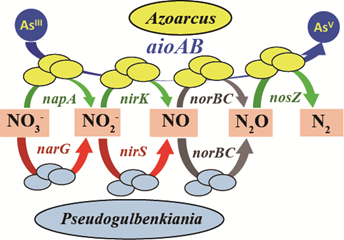Prof. Xiaomin Li from School of Environment, SCNU, collaborating with Prof. Fangbai Li from Guangdong Institute of Eco-Environmental Science & Technology, recently published a research article titled “Bacterial communities and functional genes stimulated during anaerobic arsenite oxidation and nitrate reduction in a paddy soil” in Environmental Science & Technology.
The concentration of arsenite is generally elevated during the flooding season in paddy field (Qiao et al., 2018; 2019), and arsenite has high mobility, bioavailability, and toxicity, resulting in high uptake and accumulation in the rice plant. Microbial arsenite oxidation associated with nitrate reduction might be an important process in diminishing arsenic bioavailability and toxicity to rice when paddy soils are contaminated by arsenic. In a non-contaminated soil, however, the responses of bacterial communities and functional genes to arsenite under nitrate-reducing conditions are poorly understood.
Anaerobic microcosm experiments were conducted to investigate the coupling of arsenite oxidation and nitrate reduction in a paddy soil with low total arsenic content as 3.93 mg kg-1 at circumneutral pH under anoxic conditions. Microbial oxidation of As(III) to As(V) was substantially accelerated by nitrate addition, while nitrate reduction was not affected by As(III) addition. Metagenomic analysis revealed that nitrate-reducing bacteria were principally affiliated with Pseudogulbenkiania, with narG, nirS and norBC genes. Putative As(III)-oxidizing bacteria were dominated by an Azoarcus sp. with As(III) oxidase genes aioA and aioB detected in its draft genome, which also had complete sets of denitrification genes (mainly napA, nirK and nosZ). Quantitive PCR analysis confirmed that the abundance of Azoarcus spp., aioA and nosZ genes were enhanced by As(III) addition. As previously reported, a high number of ars gene clusters was found in the genome of Azoarcus sp. CIB, and Pseudogulbenkiania spp. (such as Pseudogulbenkiania sp. strain 2002) can also stimulate Fe(II) oxidation coupled to nitrate reduction. Together with our findings, both Pseudogulbenkiania- and Azoarcus-related spp. have high adaptability and a variety of physiological and ecological attributes for arsenic and nitrogen cycling, which could potentially be stimulated to tackle arsenic-contaminated sites under anoxic conditions.

Prof. Xiaomin Li is the first author and Prof. Fangbai Li is the corresponding author of this paper. Please refer to this paper as follow.
Xiaomin Li, Jiangtao Qiao, Shuang Li, Max M. Häggblom, Fangbai Li*, Min Hu. 2020. Bacterial communities and functional genes stimulated during anaerobic arsenite oxidation and nitrate reduction in a paddy soil. Environmental Science & Technology 54 (4), 2172–2181.
Link for full-text:
https://pubs.acs.org/doi/10.1021/acs.est.9b04308
Related publication:
Jiangtao Qiao†, Xiaomin Li†, Fangbai Li*, Tongxu Liu, Lily Y. Young, Weilin Huang, Ke Sun, Hui Tong, Min Hu. 2019. Humic substances facilitate arsenic reduction and release in flooded paddy soil. Environmental Science & Technology 53 (9), 5034–5042.
Jiang-tao Qiao†, Xiao-min Li†, Min Hu, Fang-bai Li*, Lily Y. Young, Wei-min Sun, Weilin Huang, Jiang-hu Cui. 2018. Transcriptional activity of arsenic-reducing bacteria and genes regulated by lactate and biochar during arsenic transformation in flooded paddy soil. Environmental Science & Technology 52 (1), 61−70.